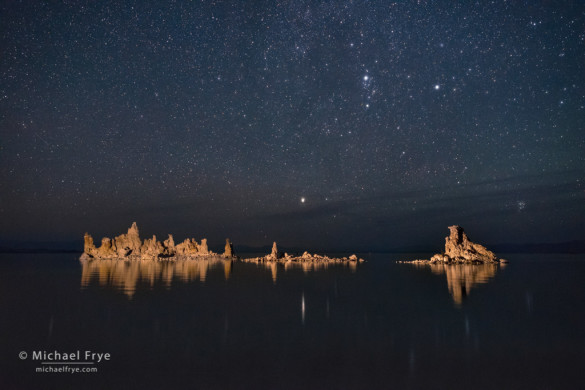
Tufa and stars (with Perseus and the Pleiades), Mono Lake. I lit the tufa formations with a flashlight during the 15-second exposure; it only took a brief pass with the light to provide sufficient illumination at 6400 ISO and f/2.8.
As I said in my last post, we had remarkably clear skies during our recent Starry Skies Adventure workshop, despite the proximity of the Walker Fire. But 24 hours before the workshop started the situation was uncertain and changing quickly. We didn’t know what would happen with the fire, and whether we’d see any stars through the smoke. Some workshop participants decided to take a rain check (smoke check?), which was completely understandable under the circumstances. But most people chose to come anyway and take their chances. In the end we had a great time. There were moments, while standing under the stars in the clear, cool, night air, when the fire seemed like a vague, distant memory.
Nothing is ever certain in landscape photography. We always have to adapt to the weather and conditions, and do the best we can with what we’re given. If you can stay flexible, things often work out, because there’s beauty everywhere, and unusual situations can create unusual opportunities. I really appreciated the intrepid sprit of our group, which helped to make the workshop feel like a fun, shared adventure.
On our first night at Olmsted Point we actually encountered a little smoke from more distant fires near Clear Lake, but that smoke settled out after dark, leaving only a little murkiness near the western horizon. On our second night we went to South Tufa at Mono Lake, and again had very clear skies. A breeze kicked up after sunset, and continued for a couple of hours, ruffling the water while we worked on star-trail sequences. But around 11 o’clock the wind died and the water smoothed out, giving us great conditions for photographing stars and the Milky Way over the lake.
We went to Bodie on our third night, which is always a treat. It had been warm at Mono Lake, but it was quite cold at Bodie that night, despite the hot temperatures during the preceding afternoon. But even though it was cold, I didn’t want to leave when our permit expired at 1:00 a.m., as there’s so much to photograph there. I’m glad I’ll get the chance to go back in early September. But in the meantime, here are a few images from Bodie, Olmsted Point, and that serene night at Mono Lake.
— Michael Frye
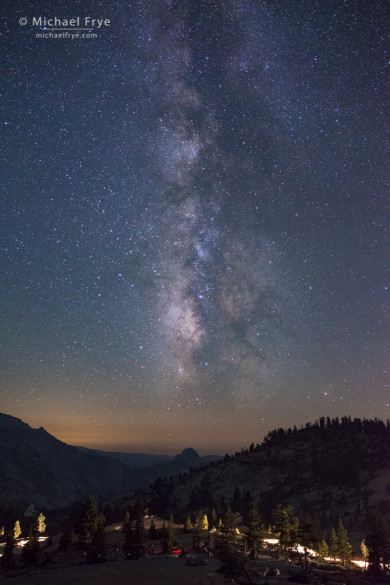
The Milky Way over Half Dome from Olmsted Point, Yosemite. I made versions of this without the car lights, but liked the curving line they created.
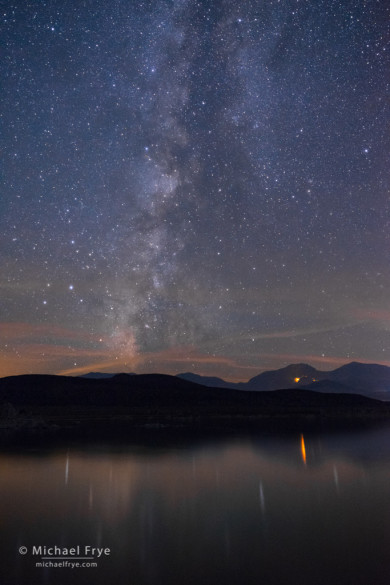
The Milky Way over Mono Lake with the glow from the Walker Fire. You can see how quiet the fire was by Tuesday night, but it still added a nice orange glow to the scene.
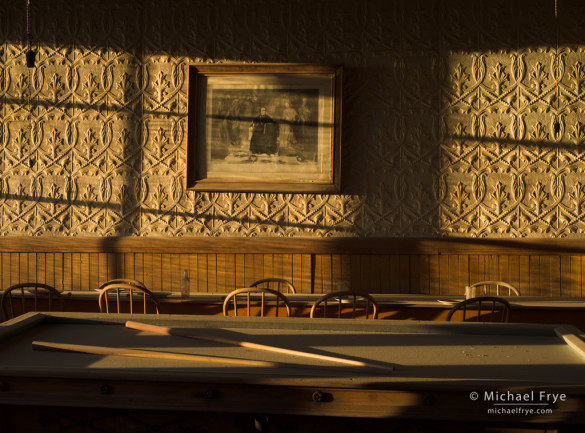
Interior of the Wheaton & Hollis Hotel, Bodie State Historic Park. I photographed this scene through a window as late-afternoon light came streaming in. The textured wallpaper is remarkably well-preserved.
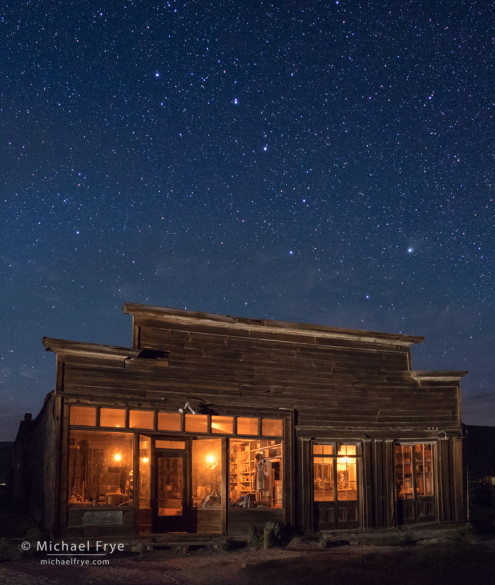
Boone Store at night, Bodie State Historic Park. The incandescent lights in the windows have been burning continuously since the 1920s.
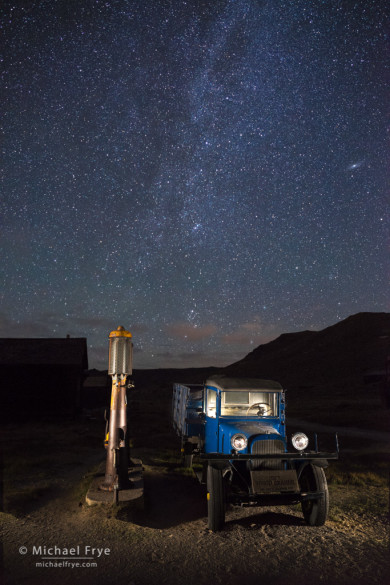
1927 Dodge Graham at night, Bodie State Historic Park. The lighting here was complex, and required blending seven separate exposures: one for the sky, two for the truck interior, and four for the truck exterior. One of the participants, Ed, helped with the lighting.
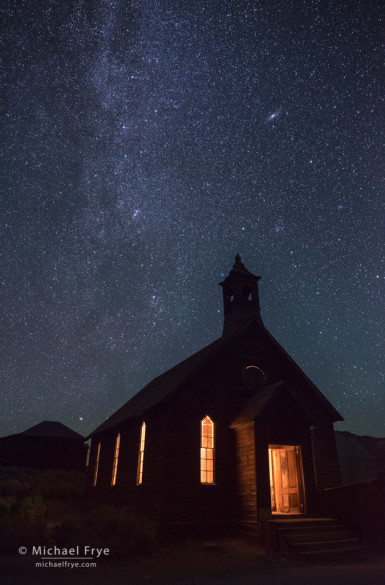
Methodist Church at night, Bodie State Historic Park. One of the participants (Ed again) lit the interior of the church by shining a flashlight through one of the windows on the opposite side while another member of the group tripped his shutter. Teamwork can often help in situations like this; Claudia went with Ed while I stayed with the rest of the group, and since Claudia and I both had radios we were able to relay information to Ed about how to refine the lighting.
Related Posts: Dodging the Walker Fire; Sand Dune and the Milky Way
Did you like this article? Click here to subscribe to this blog and get every new post delivered right to your inbox!
Michael Frye is a professional photographer specializing in landscapes and nature. He is the author or principal photographer of The Photographer’s Guide to Yosemite, Yosemite Meditations, Yosemite Meditations for Women, Yosemite Meditations for Adventurers, and Digital Landscape Photography: In the Footsteps of Ansel Adams and the Great Masters. He has also written three eBooks: Light & Land: Landscapes in the Digital Darkroom, Exposure for Outdoor Photography, and Landscapes in Lightroom 5: The Essential Step-by-Step Guide. Michael has written numerous magazine articles on the art and technique of photography, and his images have been published in over thirty countries around the world. Michael has lived either in or near Yosemite National Park since 1983, currently residing just outside the park in Mariposa, California.









Very nice (as usual) Michael! Some day I’ll be able to make it to one of your Bodie at night workshops….. I was under the impression that the meteor shower was called the Perseids?
Thanks Monika! Yes, it’s called the Perseid meteor shower. Are you asking about the caption where I mention Perseus? If so, that’s the name of the bright star right of center near the top.
You said Perseus & Pleides in the caption, that’s what confused me
Nice! You got the Andromeda Galaxy in the two of the shots! Alas, did not get my Milky Way shot, but I will try again, maybe during the September new moon.
Thanks Jim! Yes, the Andromeda Galaxy adds a nice touch to the northern part of the Milky Way.
Mike,
What light did you use to light up the Tufas out in the water and how many seconds?
Thanks,
John
A Surefire G2 Nitrolon, and about two seconds.
Beautiful night shots Michael. I really love the Milky Way over Half Dome. It seems somewhat elevated relative to the dome at the end of the trail. Is that where you were? How long was the shutter on that one?
Thanks John. I’m not sure what you mean by the “end of the trail.” If you mean the short trail out to the knob at Olmsted Point, no, that’s not where I was. We were across the road from the parking lot, up on the rock slab.
Thanks Michael. Yeah, I was referring to the end of the little trail. So you climbed the dome behind the parking lot then?
Beautiful night photography. Love Mono and Bodie.
Thanks Gary!
Beautiful images. Were all these taken with your new Sony?
Thanks John. I wouldn’t call it new, since I’ve had it for 18 months, but yes, these were all taken with the Sony A7r.
How would you shoot pictures like these with a nikon d3200? And what type of lenses are best for these type of pictures
Danica, Michael hasn’t stepped in, so allow me to give you a tip or two, based on my experience. First, shoot with the widest angle lens you can. Most of my recent Milky Way shots have been made with a 14mm prime lens, but you can shoot with a bit longer focal length. The D3200 is a crop frame sensor, so your exposure times will be a bit longer, so consult a astrophotography link to find out how much time you can keep the shutter open without incurring star trails. I shoot at ISO 3200, wide open, with 25 seconds exposure. If you want to set your white balance, bring it down to about 3250 Kelvin. Hope this helps, and that I’m not being too presumptuous in responding to your question.